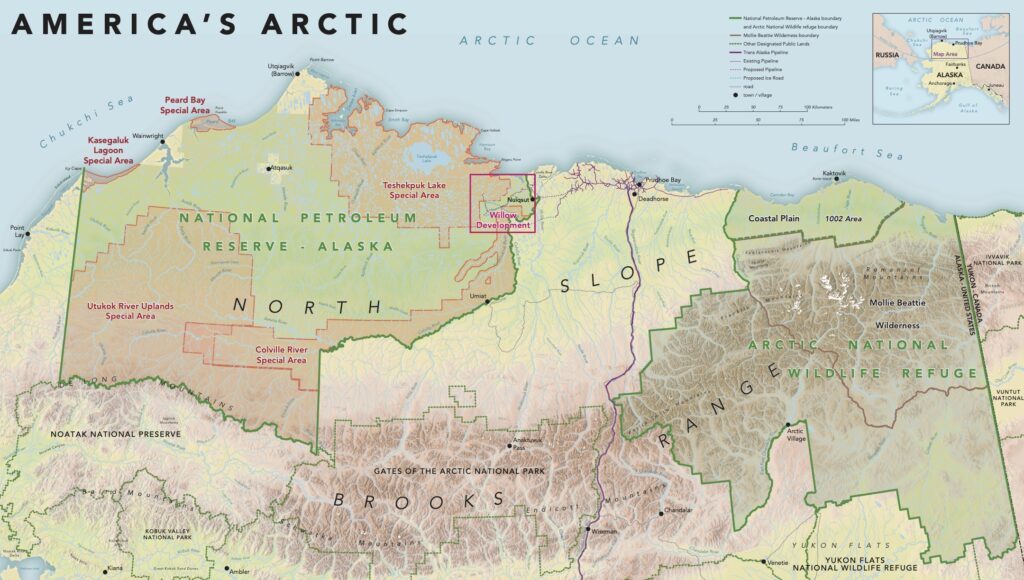From Kristen Miller: Breakdown on Strengthened Protections for America’s Arctic
What Just Happened:
The Biden administration released a final regulation for the management of the National Petroleum Reserve-Alaska (Western Arctic) that will strengthen protections for 13 million acres of “Special Areas” in America’s Arctic and set the stage for even more protections. This decision is a significant step in addressing the global climate and biodiversity crises. Press keeps rolling in, but you can read quotes from the League in AP News, ABC News and Anchorage Daily News.
Why is It Important:
Over the past half century, global climate change and biodiversity loss have dramatically intensified, especially in the Arctic. However, the regulations that govern the Western Arctic have not been updated in decades. Modernizing the way the Western Arctic is managed has been a top priority for Alaska Wilderness League since President Biden was elected. Today, the Biden administration took a major step toward our goals for this unparalleled region, and announced a process to designate more protections for the region’s unparalleled resources.
The Problem:
- The Arctic is currently warming FOUR times faster than the rest of the planet. At the same time, 25% of U.S. fossil fuel emissions have come from extraction on our public lands.
- This reality puts the Arctic in double jeopardy. ConocoPhillips and other oil companies have been relentless in their pursuit of developing more oil from this fragile region, laying out plans to access billions of barrels of oil over the next few decades from projects like Willow.
- These oil extraction activities cause devastating impacts to the fragile lands and habitat of the Arctic and this damage is coupled with longer term impacts from the burning of the oil, such as melting permafrost and shorter winter seasons that displace wildlife.
- As climate change continues to ramp up and drive biodiversity loss, protecting our public lands MUST be a part of the solution. President Biden has taken an important first step in the Arctic by increasing protections for essential habitat sitting on top of billions of barrels of oil.
A Brief History:
The Western Arctic is our nation’s largest single unit of public land, spanning nearly 23 million acres (roughly the size of Indiana) across Alaska’s North Slope. It was originally established 100 years ago as a petroleum reserve. However, the land was transferred in 1976 to the Department of Interior, under a law that required “maximum protection” for areas with extraordinary ecological significance. The Western Arctic was recognized for its globally significant habitat that sustains essential wildlife, like migratory birds, caribou, polar bears, walruses, beluga whales and more. The Iñupiat have inhabited this region for thousands of years and the Western Arctic supports more than 40 communities, with some harvesting all or nearly all of their subsistence resources from these lands. To better protect these lands, five designated “” have been created throughout the area’s history, to make certain that future generations can continue the traditions of this land – the Teshekpuk Lake, Colville River, Kasegaluk Lagoon, Utukok River Uplands and Peard Bay Special Areas. Read more about the Reserve’s history here.

What the Regulation Does:
Historically, just being designated a “Special Area” hasn’t been enough to protect these areas from oil and gas development. A perfect example: one of the three drilling pads of the massive Willow project is currently being built within the Teshekpuk Lake Special Area. Oil and gas development continues to threaten this wild landscape, with 800,000 acres of leases in existing Special Areas, and approximately 2.5 million acres leased within the Western Arctic as a whole.
This regulation sets our nation on a path to ensure there are No More Willows in America’s Arctic.
The new rule:
- Reinforces the Department of Interior’s (DOI) legal obligation to prioritize “maximum protection” for the significant resource values in designated Special Areas in the Reserve.
- Prohibits new leasing on 10.6 million acres within existing Special Areas and reaffirms a presumption against new leasing and infrastructure within 13 million areas of designated Special Areas.
- Establishes a process to create new and expand existing Special Areas and requires that these Special Areas remain intact as long as the unique values and characteristics are present.
- Begins to address what “maximum protection” means for these ecologically significant areas and establishes a straightforward process for regularly evaluating whether additional protections are needed.
These changes will set the Western Arctic on a path to a new climate future. WE THANK PRESIDENT BIDEN FOR TODAY’S ANNOUNCEMENT! To sign our postcard, click here!

But this is not the final step. While this announcement means that 13 million acres of designated Special Areas could remain free from oil and gas development, MORE protections and MORE Special Areas should be established to prevent threats from current and future projects like ConocoPhillips’ Willow project. We will not stop until we see an end to oil and gas development in America’s Arctic.
